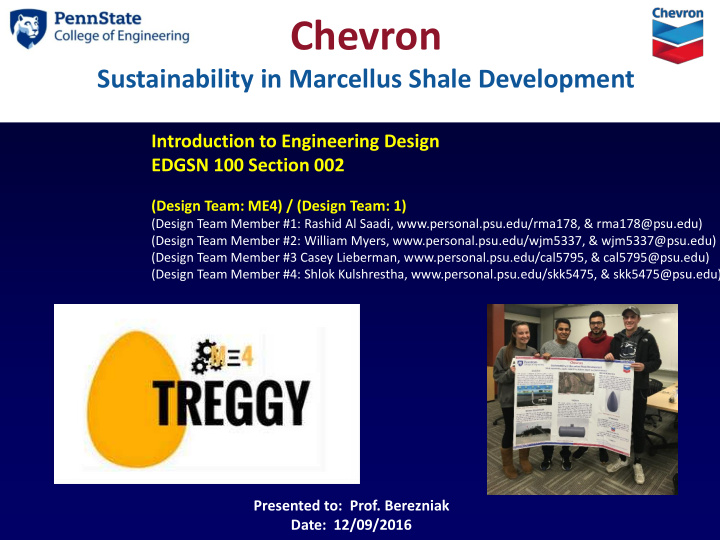



Chevron Sustainability in Marcellus Shale Development Introduction to Engineering Design EDGSN 100 Section 002 (Design Team: ME4) / (Design Team: 1) (Design Team Member #1: Rashid Al Saadi, www.personal.psu.edu/rma178, & rma178@psu.edu) (Design Team Member #2: William Myers, www.personal.psu.edu/wjm5337, & wjm5337@psu.edu) (Design Team Member #3 Casey Lieberman, www.personal.psu.edu/cal5795, & cal5795@psu.edu) (Design Team Member #4: Shlok Kulshrestha, www.personal.psu.edu/skk5475, & skk5475@psu.edu) Presented to: Prof. Berezniak Date: 12/09/2016
Objective To design a practical solution to treat contaminated water after being used in the process of extraction of shale gas in a sustainable manner as well as keeping the environment in mind. The design should also serve as an opportunity to improve upon the common industry practices and provide help to the business in terms of safety and profitability. 2
Project Sponsor • Chevron- second largest oil and gas company headquartered in the United States. • The company is a leading international energy company with more than 58,000 employees worldwide • Consistently ranked as one of the best companies to work for. “ Our industry touches the lives of millions of people in countless ways each day, providing the energy and jobs that enable us to improve our standards of living and quality of life .” 3
Natural Gas Figures (L-R) (clockwise): Describing the sources, uses of natural gases and benefits 4
Marcellus Shale Figures (R-L)(clockwise): Describing the location and Economic benefits of shale in Pennsylvania 5
Hydraulic Fracturing Process 6
Environmental Concerns • Contamination of drinking water aquifers • Use of chemicals in the process • High water storage • Fugitive Methane • Surface runoff from drill pads • Spills and leaks • Handling, treatment and disposal of water tanks • Impact on infrastructure 7
Project Description - Background Water from fracking is a main issue that has been a main reason against fracking. The water used in fracking is mixed with various chemicals that have been called “trade secrets”. This process ends with water full of chemicals and other sediment deposited in the water due to exposure to the sediments. This issue is run into and creates brine water. These chemicals cause the water to be unusable unless cleaned. 8
Project Description - Common Practice Common practices in this industry include two main processes. One is injection into deep wells. This is done in Ohio and is relatively safe but has been linked to some seismic activity and it is also relatively inefficient with energy usage. The other process is treating the water. This requires plants not like typical water treatment plants. As of right now these processes aren’t overly strict and sometimes not even thorough. 9
Project Description - Findings • Make better and improved versions of the storage tanks which are portable and easy to transport. • The process should be eco-friendly, safer and more reliable than the existing project. • The new and improved solution should help the company save time and money and help them improve their costs. • Better utilization of the site. • Use the tanks for multiple jobs which includes storing the impure water and later treating them in those tanks. 10
Project Description - Recommendations • Sedimentation • Reverse osmosis • Treatment with UV rays • Carbon nanotube treatment 11
Closing • Simulations in Solid works • Helps eliminate 5 th step from the design system process • Bi-products and their uses • Brine • Drill cuttings and sediments • Heavy metals • Disadvantages 12
Recommend
More recommend